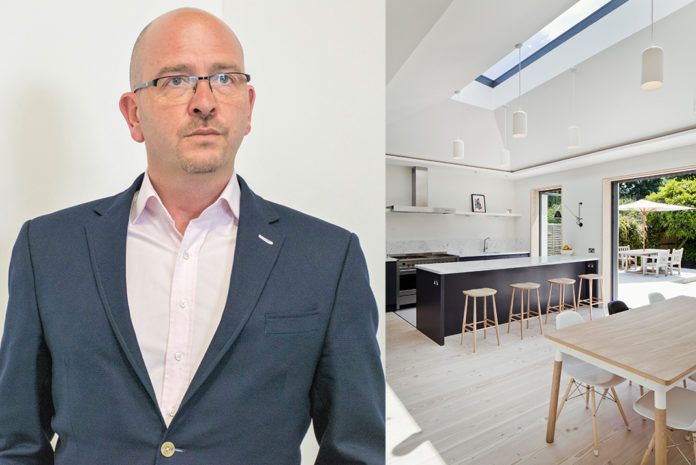Justin Seldis, managing director at Sunsquare, explains how to select a rooflight that will truly deliver, and reveals the secret behind effective upstands.
When it comes to rooflights, specifiers want to trust they’re choosing the very best in efficiency and safety standards. However, in a completely unregulated industry, more and more products are flooding the market that simply don’t make the quality grade.
Cause and effect: the consequence of an unregulated industry
When it comes to bringing in an abundance of natural light and ventilation into a building, rooflights are the perfect solution. As well as being aesthetically striking, a rooflight can completely transform a space – brightening up dark, hard-to-light areas, and bringing in much-needed fresh air, to create comfortable living and working environments. It comes as no surprise then, that demand for rooflights in building projects is increasing rapidly – both in residential or commercial settings.
But as the boom in market demand gathers pace, so has the number of products available for specification. And, in an industry that’s completely unregulated, this has led to a rise in sub-standard products that simply do not deliver on performance. It also means there’s little to prevent companies from promising outstanding credentials (such as U-Value performance) without the science or know-how to back it up.
Ultimately, it pays to know how to spot genuine quality products and performance. Not only do you want to ensure the highest levels of safety for clients (this is suspended glass over people’s heads after all), but thermal efficiency too – ensuring people get to enjoy all the benefits of comfortable living temperatures, reduced bills and lower carbon emissions. So, how can you avoid being caught out with a product that fails to live up to its promises?
Breaking the temperature transfer
If you’re looking for proper thermal efficiency, the frame is a crucial component. Keeping internal and external temperatures completely separate is the first step to ensuring optimal thermal performance – and the key to this is a properly ‘thermally broken’ frame. This means it features in-built insulating sections that ‘break’ the conductivity – providing a proper barrier to prevent heat transfer between the interior and the exterior.
Insulating sections made from multiple runs of polyamide plastic is a sure sign of a quality rooflight. For manufacturers, it can be an expensive material to use, but its role in keeping temperatures apart is second to none. Without these ‘thermal breaks,’ a process known as ‘cold bridging’ can occur where cold air from outside meets warm air inside to create unwanted condensation. Over time, this can significantly damage a rooflight, meaning an expensive replacement is likely to be needed or worse, the rooflight’s safety becomes compromised.
The secret is in the upstand
Having a properly thermally broken rooflight is just one part of the equation, and what many don’t realise, is that the upstand plays a vital role too. Designed to house the unit perfectly, the upstand is an integral part of a rooflight installation, creating enough height from the roof’s surface, and enough pitch for water to drain off effectively.
If fitted properly and to the exact measurements, a properly manufactured upstand can deliver exceptional air permeability and weathertightness. For example, incorporating highly sophisticated insulated foam can help an upstand work in conjunction with other elements of the rooflight (such as a made-to-measure frame) to bring down the overall U-value of the rooflight.
In short, the secret to achieving ultimate thermal efficiency is the combined performance of a thermally-broken frame, a well-insulated upstand, and quality, argon-filled glass. Watch out for U-value claims from the less scrupulous, that are based purely on the performance of a single pane of glass (rather than a complete unit). Whilst they may seem like impressive stats on the surface, if it fails to address how the whole rooflight performs, the numbers are actually meaningless.
Independent certification: a symbol of safety
Efficiency plays a huge part of the makeup of a rooflight, but its safety and longevity should also be a key concern. Despite the lack of mandatory quality or safety standards, the good news is, there are still companies driving the industry forward in pursuit of excellence. And its these companies that are seeking their own independent accreditation, providing customers with the quality assurance they deserve. Rooflights that have been independently verified should be the only choice, if you want to guarantee customer safety, even in the most adverse weather conditions.
Quality assurance leader the BSI has developed a BSI Kitemark accreditation specifically for flat roof skylights, a stamp of quality that Sunsquare products hold. This certification only comes with extreme levels of testing, giving users complete peace of mind that their rooflight has been built to last.
As an added safety measure, opt for laminated glass. It’s the safest glass you can get. Even in the unlikely chance of an accident, broken glass will remain fully contained within the laminate rather than presenting a risk to people below – a final fail-safe mark of quality.
Demanding more from your rooflight
While the buck stops with manufacturers when it comes to being open and honest on the performance of their product, buyers can also do their part to ensure that quality prevails. Part of this is undertaking adequate due diligence before making a rooflight purchase, making sure you know exactly what to look out for in a quality product. Yes, well-worded marketing jargon can add to the confusion, but until specifiers begin demanding only the safest, most efficient rooflights available, inferior products will continue to hang over our heads.




